Assignment on leadership Sample
Added on 2021-02-20
52 Pages12919 Words199 Views
BSBMGT605Provide leadership acrossthe organisationLearner Workbook
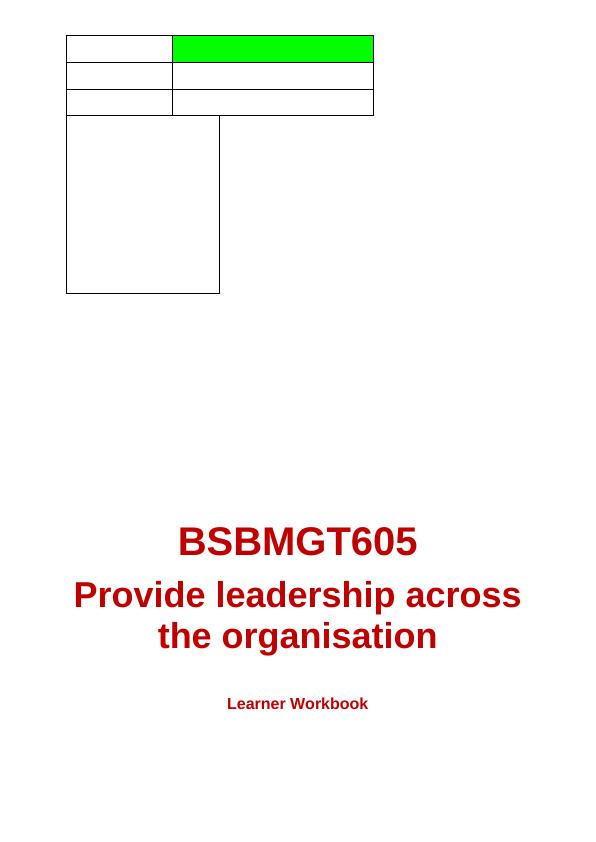
1.Assessment criteria for BSBMGT605Provide leadership across the organisation:In this document, you will find the criteria that are required to become competent in this unit. For further information on each element, you can refer to the Assessment Matrix. Included in this document are the elements for the unit, critical aspects of assessment and required skills and knowledge, as well as an assessment tool definition list and the crucial observation and third-party check lists. As well as all theareas covered here, each student must also complete all workbook activities, case studies and major activities, where stated, to become competent within this unit.NOTE – Re-assessment:Students will have maximum two (2) reassessments attempts if competency is notachieved on the first instance.The final grade of ‘S’ forSatisfactory or ‘NYS’ for Not Yet Satisfactory is only givenat the completion of the unit of competency when all components or parts of the assessment are graded.Elements for Competency Demonstration:Elements for Competency Assessment:1.Communicate organisational mission and goals2.Influence groups and individuals3.Build and support teams4.Demonstrate personal and professional competencePerformance Evidence:Evidence of the ability to use interpersonal and risk management skills to:Clearly communicate the organisation’s objectives, values and standards to a range of stakeholders using appropriate media and language Influence, support and provide resources for individuals and groups to:participate in consultations and decision-making processescontribute to innovation and improvementsachieve their responsibilities and objectives
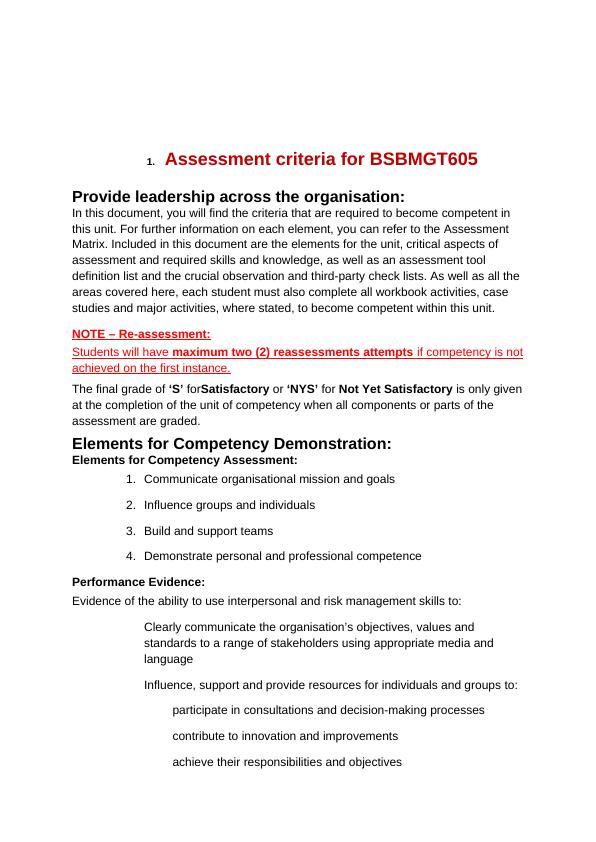
P a g e | 3Facilitate consultative decision-making processes with relevant internaland external stakeholders Demonstrate ethical conduct and professional competence and continuing professional development Encourage others to adopt business ethics and build their commitment to the organisationFoundation Skills:LearningActively looks for and accepts ways to maintain and improve own skills and knowledgeReadingEvaluates and integrates facts and ideas to construct meaning from a range of text typesWritingRecords and reports key information related to the outcomes of the job to interact effectively and appropriately with the teamResearches, plans and prepares documentation using format and language appropriate to the audienceOral communicationParticipates in a variety of spoken exchanges with clients, co-workers and stakeholders using structure and language appropriate to context and audienceNavigate the world of workWorks autonomously making high level decisions related to the achievement of organisational goalsReflects on designation of roles and responsibilities and how everyone’s role contributes to broader organisational goalsAppreciates the implications of ethical and other organisational responsibilities in carrying out own roleInteract with othersDemonstrates sophisticated control over oral, visual and/or written formats, drawing on a range of communication practices to achieve goals
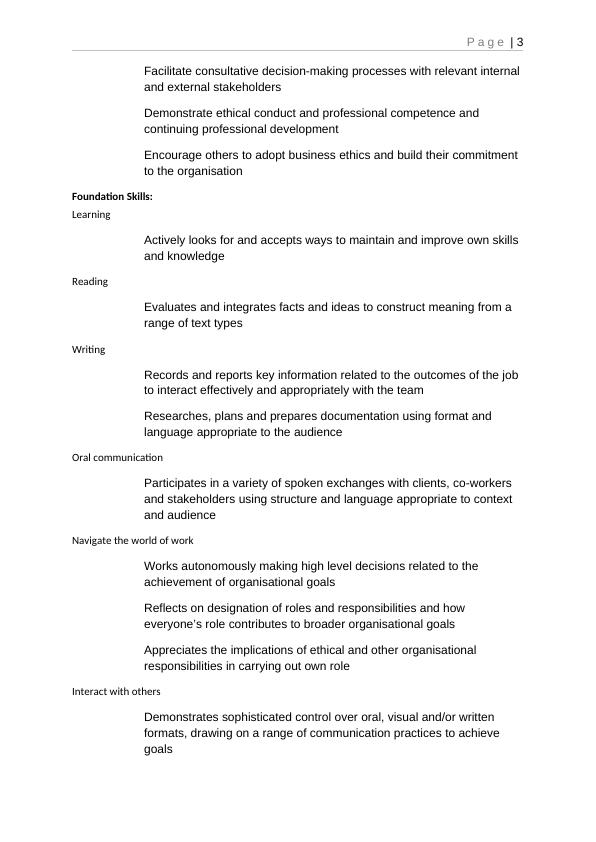
Identifies strengths and limitations of own interpersonal skills and addresses areas that would benefit from further developmentRecognises the importance of building rapport to establish effective working relationships and inspire trust and confidenceCollaborates and cooperates with others, playing an active role in leading and facilitating effective group interaction and influencing directionFacilitates a climate in which others feel comfortable to identify, exploreand build on a variety of perspectives to achieve shared outcomesGet the work doneAccepts responsibility for planning and sequencing complex tasks and workload of self and others, negotiating key aspects with others considering capabilities, efficiencies and effectivenessApplies problem solving processes to identify risks, evaluate options and determine solutionsFacilitates a climate in which creativity and innovation are accepted as an integral part of achieving outcomesActively identifies systems, devices and applications with potential to meet current and/or future needsKnowledge Evidence:To complete the unit requirements safely and effectively, the individual must:Explain business ethics and their application to leadershipOutline leadership styles and their application in supporting the organisation’s mission, objectives and valuesExplain the impact of legislation in providing leadership in the organisationExplain the organisation’s mission, purpose and valuesDescribe organisation objectives, plans and strategiesExplain organisational change processesAssessment Conditions:Assessment must be conducted in a safe environment where evidence gathered demonstrates consistent performance of typical activities experienced in the management and leadership field of work and include access to:
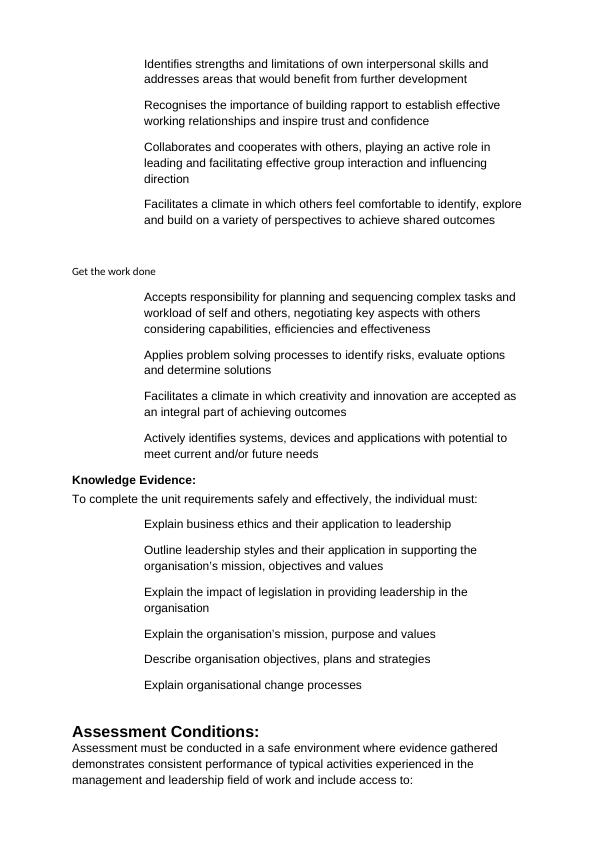
P a g e | 5Relevant legislation, regulation, standards and codesRelevant workplace documentation and resourcesCase studies and, where possible, real situationsInteraction with othersAssessors must satisfy NVR/AQTF assessor requirements.Links:Companion volumes available from the IBSA website: http://www.ibsa.org.au/companion_volumes - http://www.ibsa.org.au/companion_volumesAny observations and practical assessments must be recorded in the observation checklist. All practical tasks should be demonstrated during the length of the course. As the instructor you must maintain a record demonstrating the date of the practical activities and any comments relevant to the performance of each student. Where a student is not able to demonstrate competence in a practical observation activity, further questioning should be put in its place.As the instructor, you could be assessing the student’s literacy, numeracy and language skills, as well as the content and context of his/her answers.In some cases, you will have to adjust and amend the assessment tools, using different and varied methods (such as oral assessment), to allow students to be assessed according to their needs and abilities.Assessment Tool Definitions:Assessment ToolHow is it used? What is it?Learner Guide(To be used as an informational guide)The Learner Guide links with the Learner Workbook as it provides the information given during sessions and more. It can help students to further their knowledge and to also complete the activities.Learner Workbook Activities(Entire completion is required)Each student should be given a Learner Workbook which will hold several activities, both formative and summative, that all need to be completed in conjunction with the appropriate sessions. The PowerPoint, Learner Guide and instructor should provide further information to help with the activities.Observation/Demonstration(To be completed for each numberedpoint as stated on the checklist)An observation should be completed for eachof the students by the instructor. If the tasks aren’t everyday actions, a simulated environment is acceptable, or a demonstration can be set up. An observation checklist can be found at the end of this document.Skills and Knowledge Activity(Entire completion is required)A Skills and Knowledge Activity is a summative assessment and is found before the Major Activity in the Learner Workbook. This should take between 1-2 hours and
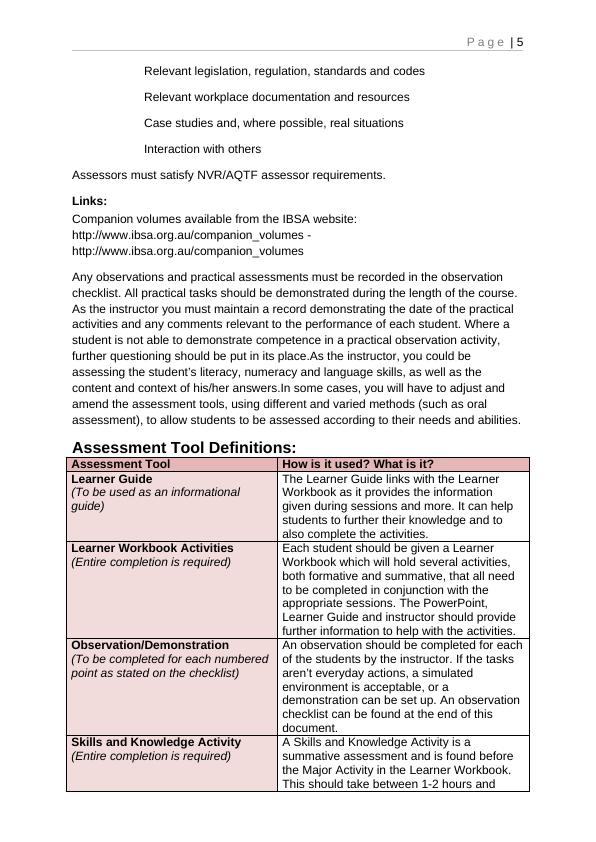
every student should complete this work. It isa requirement for each unit to check knowledge and understanding of the foundation skills and knowledge evidence.Major Activity(Entire completion is required)A Major Activity is a summative assessment and can be found in the Learner Workbook, after all the activities are completed. This is an extended piece of summative assessmentwhich should take anywhere between 1-2 hours and every student should complete thiswork. It is a requirement for each unit to check knowledge and understanding.
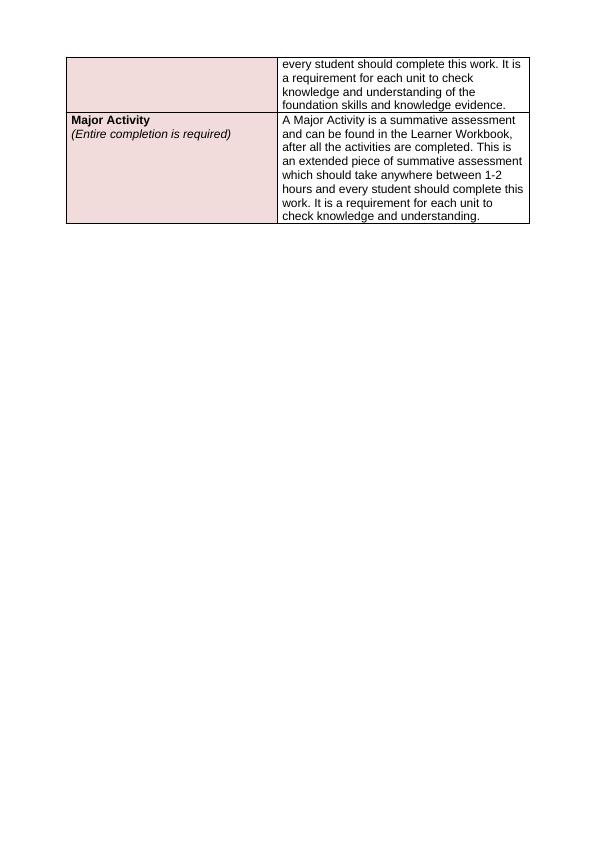
P a g e | 7Observation/Demonstration:Throughout this unit, the learner will be expected to show their competency of the elements through observations or demonstrations. The observations and demonstrations will be completed as well as the formative and summative assessments found in the Learner Workbook. An explanation of demonstrations and observations:Demonstration is off-the-jobA demonstrationwill require:Performing a skill or task that is asked of youUndertakinga simulation exerciseObservation is on-the-jobThe observation will usually require:Performing a work-based skill or task Interaction with colleagues and/or customersThe observation/demonstration will take place either in the workplace or the training environment, depending on the task to be undertaken and whether it is an observation or demonstration. Each task must be observed. You will need to ensure you provide the learner with the correct equipment and/or materials to complete the task. You will also need to inform the learner of the time they have to complete the task; this will once again vary, depending on the task.The learner will need to demonstrate they can:Communicate organisational mission and goalsInfluence groups and individualsBuild and support teamsDemonstrate personal and professional competenceLearners should also demonstrate the following skills;LearningReadingWritingOral communicationNavigate the world of workInteract with othersGet the work done

Observation/Demonstration Checklist:Unit of Competence(Code and Title)BSBMGT605 Provide leadership across the organisationDemonstration TasksCompletedMaterials and EquipmentProvidedTasks to be observed, demonstrated or simulated if appropriate YesNoComment1.Communicate organisational mission and goals: Did the learner demonstrate they could clarify objectives, values and standards in accordance with organisation's strategic direction?2.Communicate organisational mission and goals: Did the learner demonstrate they could establish linkages between organisational objectives, values and standards and the responsibilities of relevant groups and individuals?3.Communicate organisational mission and goals: Did the learner demonstrate they could ensure media and language used is appropriate to individuals and group circumstances?4.Communicate organisational mission and goals: Did the learner demonstrate they could stateclear expectations of internal groups and individualsand explain in a manner which builds commitment to the organisation?5.Communicate organisational mission and goals: Did the learner demonstrate they could address expectations of the organisation?6.Communicate organizational mission and goals: Did the learner demonstrate they could investigate incidentspromptly and communicate results clearly to relevant groups and individuals?7.Influence groups and individuals:Did the learner demonstrate they could build trust, confidence and respect of diverse groups and individuals through positive role modelling and effective communication

End of preview
Want to access all the pages? Upload your documents or become a member.
Related Documents
Assessment criteria for BSBSUS501 Develop Workplace Policy and Procedures for Sustainabilitylg...
|48
|9105
|85
Develop and Manage Performance Management Processes Learnerlg...
|58
|13212
|11
Manage Human Resource Serviceslg...
|65
|8224
|25
BSBHRM501 | Manage Human Resource Serviceslg...
|63
|8946
|10
BSBDIV601 Develop and Implement Diversity Policy Learnerlg...
|47
|11250
|27
BSBMGT403 Implement Continuous Improvement Learner Workbooklg...
|40
|6531
|304